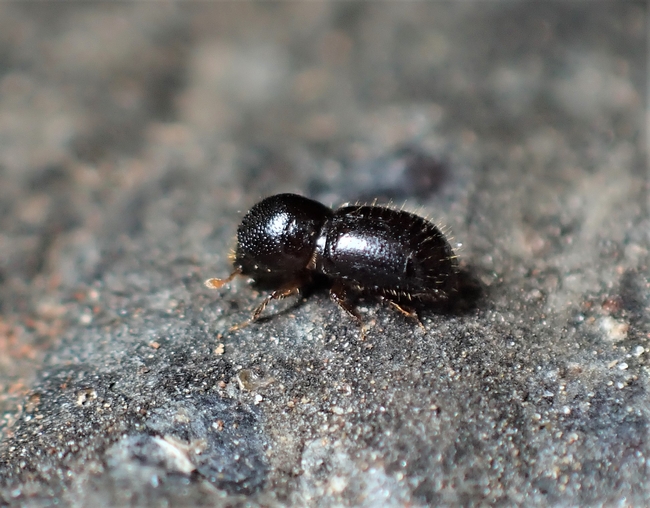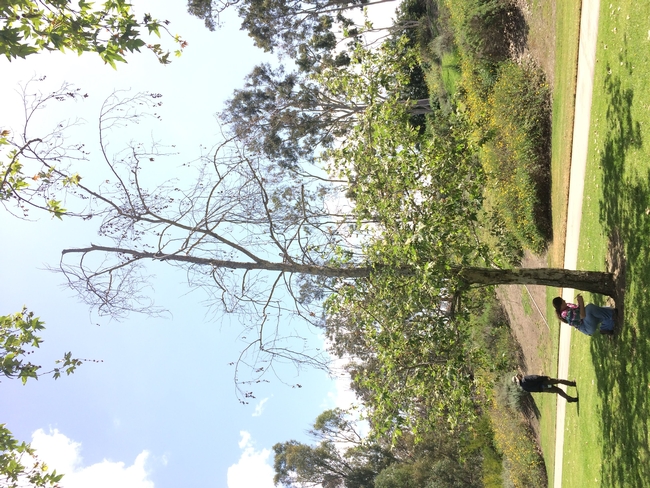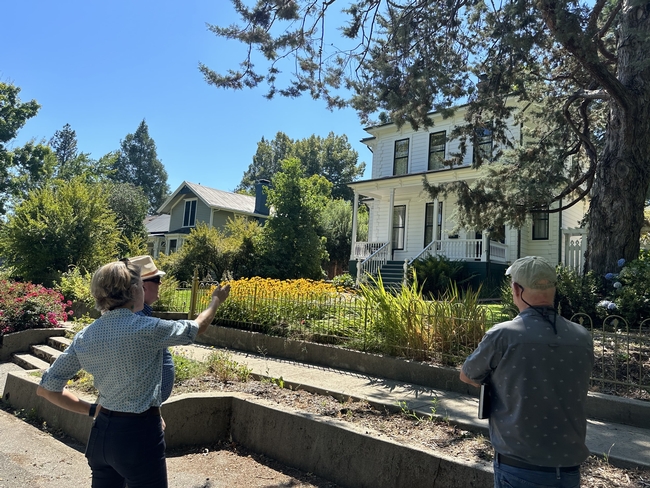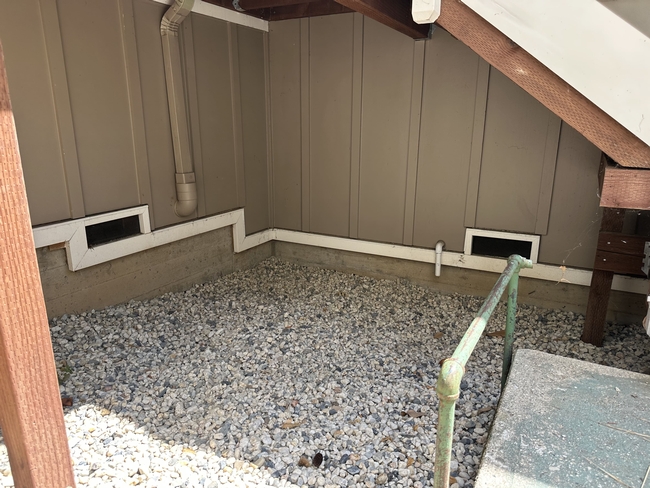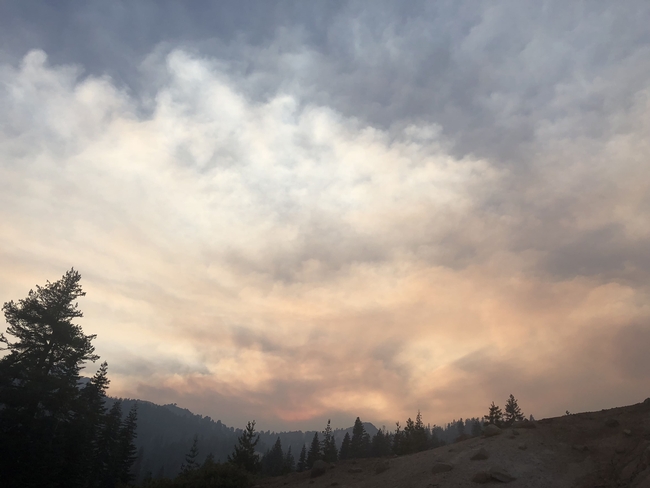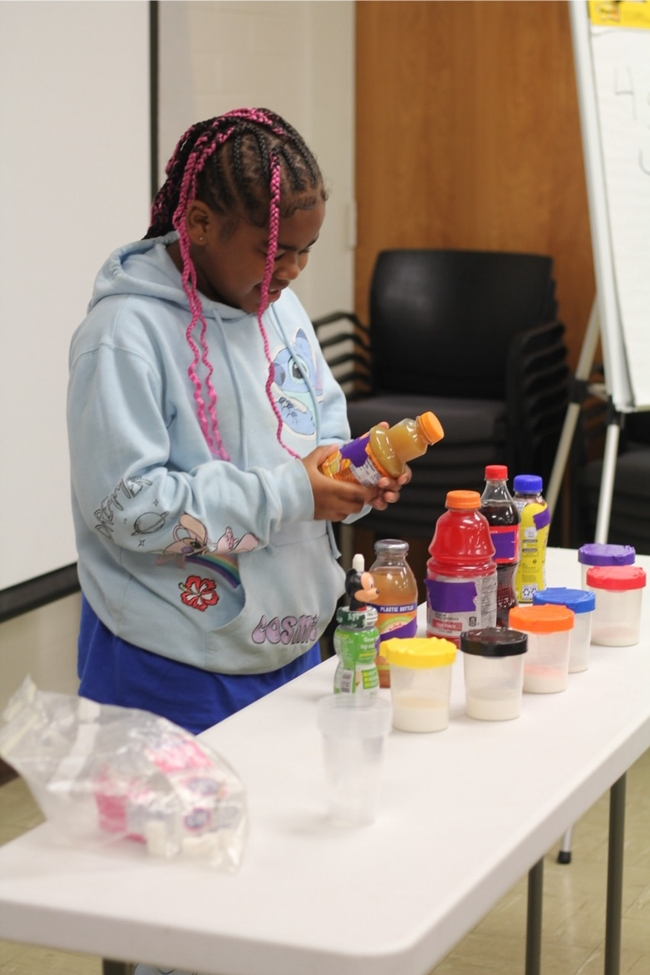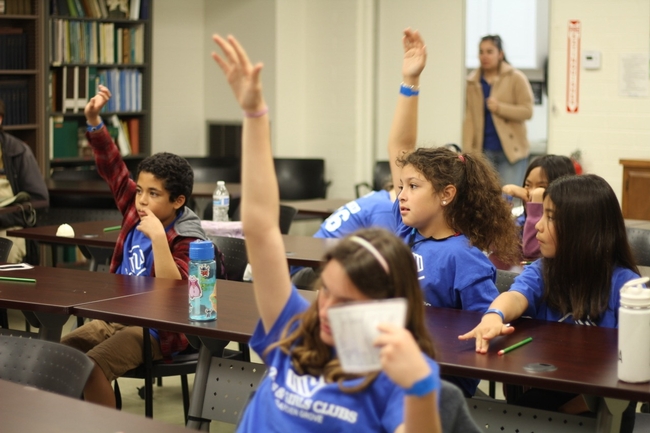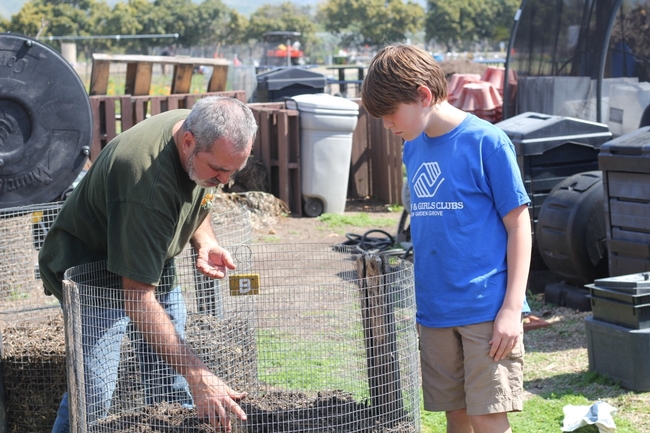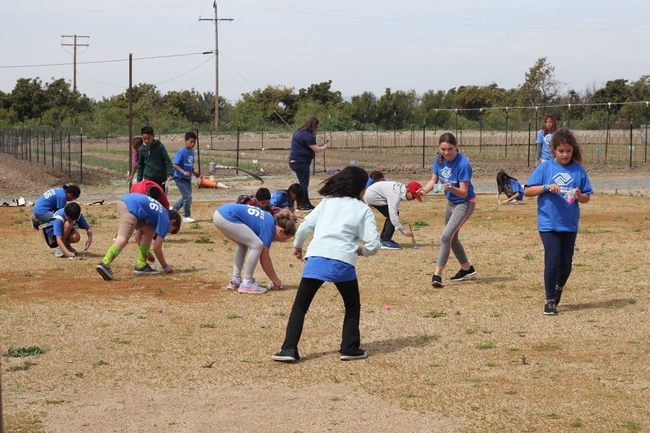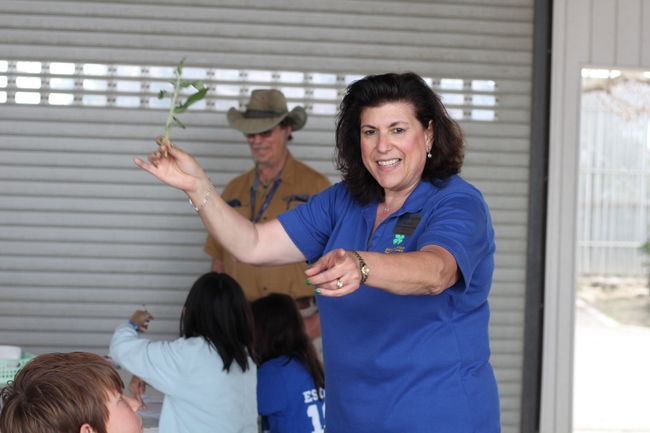Posts Tagged: garden
UC ANR experts, resources guide response to shothole borers in Bay Area
UC Cooperative Extension scientists, partners managed invasive beetle in Southern California
Late in 2023, a potentially devastating beetle was detected in the San Francisco Bay Area for the first time. But land managers, arborists and agency staff have one big advantage as they devise plans to control the invasive shothole borers (ISHB).
Thanks to collaborations led by University of California Agriculture and Natural Resources, they can draw upon the hard-earned experience of their colleagues in Southern California. Over the past decade, SoCal communities have lost “tens of thousands” of trees due to ISHB infestations, according to Beatriz Nobua-Behrmann, UC Cooperative Extension urban forestry and natural resources advisor for Los Angeles and Orange counties.
In one regional park, about 500 trees had to be removed in the span of just one year. “That kind of impact happened in many locations; a whole street might lose 90% of the trees – all of a sudden,” said Nobua-Behrmann, a member of a statewide network studying ISHB.
Spurred by such severe impacts, UC scientists have been studying ISHB and testing various control measures since about 2012. Their lessons are now informing efforts in San Jose – where the first case in the Bay Area was detected in November 2023 – and across the region.
“The UC ANR team is comprised of subject-matter experts,” said Drew Raymond, interim agricultural commissioner for Santa Clara County. “The team has compiled all of the experience from the agencies that have been doing work in Southern California and transplanted that experience here to Northern California.”
Lucy Diekmann, UC Cooperative Extension urban agriculture/food systems advisor, and Igor Lacan, UCCE environmental horticulture and urban forestry advisor, have coordinated regular meetings and trainings of Bay Area agricultural officials, land managers and arborists.
“Lucy and Igor have been instrumental in organizing our partners to establish an effective plan for shothole borers,” said Sara Davis, city forester for San Jose. “Because experts across the broader UC ANR network have many years of firsthand experience with this invasive pest, we are able to draw on their practical know-how to guide our monitoring, management and public education efforts.”
Davis is leading a trapping program in San Jose to determine how widespread ISHB is. Aside from a recent detection in the Santa Cruz Mountains, almost all of the approximately 30 confirmed cases in Northern California have been clustered along the riparian corridor of Coyote Creek through downtown San Jose. This pattern of intense but geographically limited damage was also seen across Southern California – notably in San Diego County along the Tijuana River Valley, where ISHB wiped out the willow population.
“I would expect us in the Bay Area to see this type of localized damage that is not fundamentally different from what they're seeing in Southern California,” Lacan said.
Unusually troublesome pest triggers deadly tree disease
The invasive shothole borers – a term for two species that are virtually indistinguishable, the polyphagous shothole borer and Kuroshio shothole borer – were first detected in Los Angeles in 2003. The tiny beetles, measuring 1.5 to 2 millimeters in length, became a major concern a decade later when swaths of urban forest began dying across LA County.
Infestations are harmful – and fatal for at least 17 tree species in California – because the fungus that the beetle “farms” as its food source causes a disease called Fusarium dieback. Alarmingly, ISHB make their home in a wide variety of trees; Nobua-Behrmann said 65 tree species in California have been identified as “reproductive hosts” where they can grow their populations.
“The fact that they are such a generalist species means that they can find a host almost anywhere,” she said, noting that sycamore, box elder, cottonwoods, oaks and willows are favorites of ISHB.
Furthermore, typical tools in the integrated pest management toolbox are unavailable or ineffective for this invasive beetle. Unlike most insects, these shothole borers mate with their siblings before leaving the tree, so they don't need to search for mates afterward. This means they are not attracted to the pheromone traps typically used for pest control; traps used for ISHB only work to track their numbers, not reduce them.
“Their biology limits what we can do,” Nobua-Behrmann said. “Since the beetles spend most of their lives inside the trees, it's also hard to reach them with insecticides.”
Largely hidden within trees, ISHB can build up their numbers, undetected for years. A tree with green and plentiful leaves may in fact be harboring a significant infestation. “It's easy for this beetle go under the radar and create a big population and a big problem before you even notice,” Nobua-Behrmann said.
Monitoring and early identification of infestations are crucial
Given this pest's elusive nature, monitoring and early intervention have proven to be essential in Southern California.
“All of the success stories have a major component of monitoring and detection; if you have a good monitoring program and you can quickly identify the trees that are infested, timely action can make a big difference,” said Nobua-Behrmann, citing Disneyland in Anaheim as one example where frequent surveys and robust monitoring prevented major impacts.
As most municipalities don't have the abundant resources of a world-famous theme park, Nobua-Behrmann pioneered a program in Southern California to train community members on recognizing telltale signs of the beetle. Specifically, they looked for its entry holes, which have a characteristically round shape and size, comparable to the tip of a ballpoint pen.
Beginning with UC Master Gardeners and UC California Naturalists and then members of the general public in LA and Orange counties (and later other SoCal counties), the program trained about 100 people on how to look out for the beetle. After verification by experts, volunteers were found to be nearly 90% accurate in identifying ISHB.
Although the volunteer monitoring program is on hiatus, Nobua-Behrmann said it had clear benefits that could potentially help other regions. “It would be great to get this program going in Northern California and hopefully get volunteers and people in the general public to help identify infestations there as well,” she said.
Statewide ISHB network spreads essential information
In addition to coordinating an in-person public training in San Jose in April, Lacan and Diekmann, the UC Cooperative Extension advisors, have been educating local UC Master Gardeners on how to spot signs of the invasive beetle.
For about a decade, Lacan has been warning people about the possibility of ISHB in Northern California, routinely including shothole borers in his presentations on “tree pests to watch.” “I've been doing this since before ‘day zero,' but there was not a whole lot of interest in ISHB, as you might imagine,” Lacan recalled. “But then all of that changed in fall of last year.”
In the past year, Lacan has done a dozen ISHB presentations, workshops and webinars, attended by a total of about 260 people – predominantly city foresters, land managers, production arborists and members of tree-related nonprofits.
Lacan noted that the most effective presentations have been at in-person events featuring UC ANR-affiliated experts such as Nobua-Behrmann, UCCE environmental horticulture advisor emeritus John Kabashima, and ISHB program staff Randall Oliver and Hannah Vasilis.
“Here is where we tap into our network,” Lacan said. “This is the power of the statewide shothole borers program.”
Another vital asset has been the collection of practical resources gathered by the ISHB program, the UC Integrated Pest Management team and partner organizations. One example is a deck of identification cards depicting how symptoms of infestation differ from species to species. Such detailed information can help managers determine whether a tree is truly infested – and thus allocate their limited resources more judiciously.
“These very specific, very seriously considered materials are the kind of thing that people really appreciate,” Lacan said. “It's not just a generic ‘it's kind of like this.'”
The symptoms, broken down by tree species, are also listed on the ISHB website. Raymond, the interim agricultural commissioner for Santa Clara County, said his team uses the website to get informed about ISHB and regularly refers community members to it.
“The ISHB website has been a great resource,” Raymond said. “It's full of important and user-friendly information.”
Communities learn to protect trees, adapt to shothole borers
If community members believe a tree is infested, they should review the symptoms of ISHB-Fusarium dieback. If the signs match what they are seeing, they should take a photo of the entry hole (with the tip of a ballpoint pen placed next to the hole as reference) and send images to their county agricultural commissioner's office or local UCCE advisor, who may then seek confirmation.
Extra eyes on urban forests are crucial to help experts identify potential “amplifier trees” – heavily infested trees, with more than 150 entry holes, that are often repeatedly reinfested by subsequent generations of beetles. They contribute to the recurring pattern of severe but localized infestations seen across Southern California – and now in San Jose.
New research suggests that removing severely infested trees – or just the most impacted limbs of those trees – can significantly lower the overall ISHB population and help less-infested trees in the area recover over time.
“You're not going to eradicate ISHB (at least not in Southern California); you're not going to get rid of them – you're going to have them forever,” Nobua-Behrmann said. “But you can keep them at a manageable amount.”
She also emphasized other actions the public can take to prevent the spread of ISHB, such as correctly disposing infested plant material – ideally chipping it to less than an inch in length (or as small as possible) and then composting the chips.
“It's also important to not move firewood and instead buy it where you will be burning,” Nobua-Behrmann said. “It's one of the best things people can do to protect trees from invasive pests.”
After identifying and removing amplifier trees, land managers and landscape arborists should have a plan for replanting, Lacan added. He said they should prioritize species that are less susceptible to the beetle, using his Pest Vulnerability Matrix tool that lists the major pests for different mixes of trees.
“We need to figure out how to have sustainable urban forests, even with this pest,” he said. “We know we can do it, largely thanks to our colleagues in Southern California. So the key lesson is to replant soon – choose smartly, but replant right away.”
UC Master Gardeners equip Orange County’s Spanish-speaking community to garden on a budget
Since joining the University of California Master Gardeners of Orange County in 2022, Ana Peeks has been on a mission to share all that gardening has to offer, especially for the Latino community in her neighborhood.
“We've got to empower our Spanish-speaking community. They're one of the most vulnerable when it comes to food insecurity,” said Peeks. In partnership with Heather Hafner, a fellow UC Master Gardener, and the First Christian Church of Orange in Orange County, Peeks organized an opportunity for community members to learn introductory gardening in Spanish.
Every Tuesday for six consecutive weeks, 14 participants gathered in a conference room at the church. The course uses Seed to Supper, a program that was developed by Oregon State University Extension to teach food insecure communities how to grow their own food on a budget.
“The great thing about the Master Gardener community is that it stretches across the entire country, and we are able to draw upon fantastic programs and curricula from our partner organizations,” said Randy Musser, UC Master Gardener program coordinator for Orange County. UC Master Gardeners are supported statewide by UC Agriculture and Natural Resources.
Hafner, who has waited for the Seed to Supper program to be available for public use since 2019, completed the required facilitator training by OSU and was given access to the curriculum earlier this year. After learning that Peeks, a first-year UC Master Gardener, wanted to teach gardening to her church community but wasn't sure how to get started, Hafner jumped at the chance to collaborate.
Currently available in English and Spanish, the Seed to Supper curriculum is also customizable, said LeAnn Locher, OSU Master Gardener outreach coordinator.
“Even though it was created based on Oregon's climate, you can certainly adjust the curriculum to suit other growing conditions, including Southern California,” Locher added.
Together, Peeks and Hafner modified the program to suit the needs of the Orange County community, particularly which vegetables to plant during the different seasons.
Over the six weeks, the participants learned about topics such as soil health, fertilization and how to seed plants. The Great Park, a public park in Irvine, donated thousands of seed packets for a variety of fruits and vegetables.
Although she is always encouraging participants to expand their palates by growing new and different fruits and vegetables, Peeks also understands the importance of growing food that they typically consume and are familiar with. The participants provided a list of seasonal vegetables that they wanted to grow, mostly jalapeños, tomatoes, squash, melon and lettuce.
Because space in the home is a limitation for many, the course included lessons on vertical versus horizontal planting, as well as container gardening.
Program organizers removed barriers to participation
Several of the participants shared that the course has had an impact on their family. “I have more confidence that l can cook with what I learned from the course. I now know that I have to make good food choices for my family,” said Martha Montiel.
In addition to cooking the food they grow, participants said that gardening has created an opportunity to unite family and friends.
During class, Peeks instructs in Spanish and Hafner offers support in English, which Peeks then translates. While language is a barrier that both UC Master Gardeners were prepared to address, childcare was also top of mind. During class, on the opposite side of the conference room, you will see children watching a movie so their mothers, a majority of the participants, can be fully engaged in Seed to Supper.
Peeks was also mindful about transportation to and from class. Since many of the participants were already commuting to First Christian Church of Orange on Tuesdays for their food distribution program, it was convenient to host the class before the food distribution center opened to the public.
After receiving their certificates of completion, Peeks said she observed participants exchange vegetable planting experiences and give regular updates on their crop's progress. “Some participants are sharing their crops, gardening experiences and what they have learned with their friends and neighbors, too,” Peeks added.
Like Montiel, Amy Correa said that after taking the course, she assesses food before she buys it. “I look at the produce, read the labels, see if it's organic and where it was grown,” said Correa, adding that the course has motivated her to make healthier choices for her and her family.
One of the challenges that remains for Peeks and Hafner, however, is the cost of supplies. Hafner and her husband have donated large pots and soil to help participants get their gardens started, but both UC Master Gardeners envision participants having access to more tools like gloves, trowels, pots of various sizes and pruning shears.
“Extending information and sharing knowledge is the most important thing about these classes. But our impact can be so much greater when we're able to provide everything they need to get started. This includes tools,” Hafner said, noting that doing so aligns with their effort to remove barriers that hinder a participant's success in the program.
If you would like to donate to the UC Master Gardeners of Orange County, please do so here: https://donate.ucanr.edu/?program=UC_Master_Gardener_Program&county=Orange.
UC Master Gardeners of Imperial County grow from Mexican, Latino roots
First program of its kind in area establishes free seed library, community garden
One of the many things that make University of California Cooperative Extension in Imperial County unique is its close proximity to the U.S.-Mexico border. Its geographic location, with a border town called “La Frontera” by locals, infuses the UC Master Gardener Program in this area with intercultural knowledge.
In 2022, UCCE launched its first UC Master Gardener Program in the county and has maintained a cohort of 20 participants since then. Kristian Salgado, the program's first coordinator, said the volunteers offer a range of skills to the gardening community.
“The clientele that our volunteers serve tend to be individuals who have gained their gardening knowledge and experience from tending to plants in their homeland of Mexico,” said Salgado. The volunteer UC Master Gardeners of Imperial County reflect the region's predominantly Latino demographic, making it easier for volunteers to connect with their clientele.
“Nopales, chiles, citrus…residents in this region know how to take care of these plants. They've done it all their life. But when you have a program like the UC Master Gardener Program, you can use science to explain why their practices worked all these years,” said Salgado.
According to Salgado, the UC Master Gardener Program can be perceived as too academic for some residents. “It's not a bad thing, but I had to digest the information myself, even the UC Master Gardeners, and figure out how to deliver it in a way that was relevant to everyone,” she added.
As a starting point, Salgado used English and Spanish materials from neighboring counties like “A Garden of Words/Un jardín de palabras”, developed by the UC Master Gardener Program of Los Angeles County.
One method that helped engage volunteers and residents during classes was the use of culturally significant seeds like chiltepin peppers – seeds that Salgado deems a “must-have” if you are a gardener of Mexican heritage.
“When we focused on plant propagation, the volunteers that I worked with agreed that we should propagate plants that our residents were familiar with and use in their everyday cooking,” Salgado explained.
This same approach was employed at the free seed library and demonstration garden – both established and maintained by the UC Master Gardener volunteers at the City of Imperial Public Library. During the warm season you can find Roselle (Hibiscus sabdariffa L.), known to make agua de jamaica, in the seed library – something you won't easily find in grocery stores. In the demonstration garden during the summer, you'll notice a variety of peppers such as chile güero, jalapeño, serrano and habanero.
As the UC Master Gardener coordinator for Imperial County for the last two years, Salgado has focused her leadership on establishing a program that would generate opportunities for UC Master Gardener volunteers to create projects that are reflective of their interests, align with the program's mission and serve all residents in the county. The demonstration garden, which is the first community garden established in the city of Imperial, is an outcome of Salgado's vision.
UC Master Gardener Program reflects, connects community
Eliza Barajas, UC Master Gardener of Imperial County, who works at the library during the week and has witnessed the impact of the garden, said it gives her a sense of pride. “I moved to the [Imperial] Valley a year ago and I was looking for a way to connect with the community. I couldn't have asked for a better program to do that, and I'm so proud to say that I'm a part of the very first cohort in Imperial County,” Barajas shared.
Salgado praised Barajas for her enthusiasm in the program and noted her excellent ability to speak Spanish. “I love the way Eliza flows from English to Spanish. It's effortless! And it comes in handy when we're doing community events and need to cater to our Spanish and English speakers,” said Salgado.
Since the program came to fruition, Salgado has played a pivotal role in the program's progress. Reflecting on why she accepted the role of UC Master Gardener coordinator for Imperial County, Salgado said that the role was a culmination of everything she studied in school and cares deeply about.
While attending California State Polytechnic University, Humboldt, Salgado earned a master's degree in social science focused on the environment and community. She studied the intersections of food insecurity, the agricultural industry and health inequities, and how they specifically impact the Latino community.
Growing up and currently living in Calexico, Salgado questions why her community is food insecure. “Imperial is the ‘salad bowl' of the nation. We export a variety of fresh fruit and veggies all year long. How is it that our community doesn't have enough access to the healthy food it produces?” she asked.
Food security is one concern that Salgado envisions the UC Master Gardener Program addressing through its seed library, community garden and gardening classes.
Following graduate school, Salgado moved back home and joined former classmate and UCCE colleague, Chris Wong, in establishing the first farmer's market in Calexico in 2013. Wong encouraged Salgado to apply her new knowledge and skills at UCCE Imperial County, where she began working as a climate-smart agriculture community education specialist in 2019, supporting growers with grant writing.
“I realized early on that there was a lot of divestment in the community, and I didn't understand why,” she said, adding that she's still working to understand. Salgado's mother-in-law also continuously challenged her to think bigger. “My mom-in-law comes from the Chicano Movement. She's guided me into thinking more critically about the issues we face in our community and as Latinos.”
In September, Salgado began in a new role as the regional operations specialist for the UC Master Gardener Program statewide office, covering the Bay Area to Southern California regions. Salgado hopes to develop useful tools and resources to support coordinators' professional development, while integrating programmatic best practices centered on diversity, equity, inclusion and justice.
“The UC Master Gardeners are full of knowledge, and my education was motivated by identifying how Latinos can get a seat at the table. UC Master Gardeners easily become trusted sources in the community, and for Imperial County, this is how they get a seat at the table,” said Salgado.
Simple tasks make big difference in preparing for wildfire, smoke
UC ANR Fire Network compiles expert advice on preparedness, evacuation tasks
The explosive growth of the Park Fire in Northern California was fueled by recent, intense heat waves and extremely dry vegetation – conditions seen at many locations across the state.
Given the potential for wildfire and smoke impacts during what is expected to be a protracted “fire season,” California residents should think ahead and complete emergency preparations: https://ucanr.edu/sites/fire/Preparedness/.
“If you are concerned that you or someone you know could be affected by fire or smoke, now is the time to take simple steps to prepare,” said Yana Valachovic, University of California Cooperative Extension forest advisor for Humboldt and Del Norte counties.
Valachovic and other members of the UC Agriculture and Natural Resources Fire Network are urging community members to tackle small but significant tasks to minimize potential fire damage. Many of these tasks can be finished in a weekend, such as:
- Clean debris from your roof and gutters.
- Inspect the area around your home and nearby structures and remove all combustibles (dead grass, plants, woody mulch, stored wood, etc.) in the first 5 feet, including under decks and stairs.
- Inspect the foundation, under-eave, and gable-end vents for holes and damage; add a layer of finer metal-mesh screens (1/8” mesh) to the vents to prevent ember penetration.
- Inspect the garage door bottom seal to make sure embers can't blow under the door.
- Replace the first 5 feet of wooden fences that attach to buildings with a noncombustible panel or gate.
A recently published report, “Retrofitting a Home for Wildfire Resistance,” also can help residents prioritize the measures that are most cost-effective and fit their budget.
Six things to do, six hours before evacuation
As evacuation warnings are issued for local communities, there are six important things to do in advance of an actual evacuation order, according to Valachovic:
- Close windows, pet doors and skylights.
- Move inside patio cushions, brooms and door mats; tie open wooden gates that attach to the house or deck to prevent a fire from traveling from the fence to the house.
- Relocate the barbecue propane tank away from home.
- Stage buckets of water and garden hoses in visible locations.
- Dress for evacuation: cotton clothes, sturdy shoes, hat and face protection and leather gloves.
- Put your “go bag” in your vehicle.
The UC ANR Fire Network website also includes downloadable checklists – in English and Spanish – for your go bag (https://ucanr.edu/sites/fire/Safety/Evacuation/Preparing_a_Go-Bag/) and for a host of important pre-evacuation tasks for your household, property, pets and livestock (https://ucanr.edu/sites/fire/Safety/Evacuation/).
“We want communities to be wildfire-prepared – not scared,” Valachovic emphasized.
Smoke exposure a significant public health concern
Hazardous smoke can blanket wide swaths of California – and much of the Western U.S. – during ongoing wildfire events. A primer on harmful health effects, a list of tips for reducing smoke exposure, and other resources and links can be found on the UC ANR Fire Network site: https://ucanr.edu/sites/fire/Safety/Air_Quality_and_Smoke/.
“If there's smoke in the forecast for the next few days, I would keep an eye on my local air quality at fire.airnow.gov,” said Katie Low, statewide coordinator for UC ANR's Fire Network. “And if the AQI – Air Quality Index – is high, I would limit my outdoor activity, wear an N95 mask if I do go outside, and run my air purifier.”
For instructions on making a DIY air cleaner, creating a “clean air space” in your home and fitting an N95 mask properly, visit the California Air Resources Board's “Smoke Ready California” page: https://ww2.arb.ca.gov/smokereadyca.
Another useful tool is the crowd-sourced #FireMappers fire activity map – powered by the National Alliance for Public Safety GIS Foundation, GISCorps, and CEDR Digital Corps – accessible through the UC ANR Fire Network site: https://ucanr.edu/sites/fire/Safety/Current/.
4-H, Boys and Girls Club, UCCE partner to inspire Orange County kids
Small containers with varying levels of sugar sit next to a row of beverages, including water, fruit juices, soda, a sports drink and chocolate milk. Trying to match each container with the beverage that contains its corresponding amount of sugar, Amore, a fourth grader, reads the nutrition label on the orange juice bottle. “What does the bottle say?” asked a student in the audience, attempting to help Amore.
Life skills such as how to read a nutrition label are representative of learning that youth can expect when joining 4-H, a nationwide program focused on empowering kids ages 5 to 18. 4-H offers experiential learning opportunities ranging from STEM (Science, Technology, Engineering and Mathematics) and healthy living to civic engagement and leadership.
To expand its reach and make their program more accessible, 4-H launched a digital learning platform called CLOVER by 4-H that offers content tailored for three types of users: learner, parent and educator. As the platform grows in popularity, 4-H is eager to identify best practices in engaging new users to join the platform and retain their interest.
More than 250 free 4-H lessons
In California, 4-H programs are overseen by University of California Agriculture and Natural Resources. Given its successful contributions to statewide initiatives in the past, 4-H in Orange County, administered through the local UC Cooperative Extension office, was one of three counties selected to participate in a CLOVER pilot project in conjunction with the National 4-H Council. With more than 250 4-H lessons available online at no cost, the pilot project aims to introduce its users to 4-H.
To generate interest, 4-H in Orange County is leveraging connections to local Boys and Girls Clubs. In March, they hosted more than 20 kids from the Boys and Girls Club of Garden Grove (BGCGG) – including Amore – for a day of learning and exploration at the UC South Coast Research and Extension Center in Irvine, where the 4-H program for Orange County is based.
Rita Jakel, community education specialist and program coordinator for 4-H of Orange County, said that partnering with BGCGG will, hopefully, inspire its members to join their local 4-H club.
“The youth created a CLOVER account before engaging in eight CLOVER lessons taught by the staff at the Boys and Girls Club during their weeklong Spring Break Day Camp,” said Jakel, noting that the participants were introduced to 4-H before arriving to South Coast REC for in-person activities.
Interactive nutrition and gardening lessons
During their visit, the participants engaged in a typical day of 4-H lessons featuring presentations from the local Expanded Food and Nutrition Education Program (EFNEP) and UC Master Gardener volunteers. Jakel then wrapped up with interactive sessions on animal adaptations—understanding the challenges animals face in gathering food—as well as lessons on growing and cooking with herbs.
“One of the most rewarding aspects of working with young people is the opportunity to creatively educate them on various subjects, ensuring that learning is both enjoyable and engaging,” said Javier Miramontes, community nutrition and health supervisor for EFNEP in Orange and Los Angeles counties, who started the day off with the lesson on nutrition labels.
Miramontes visually explained how much sugar is found in various beverages and then challenged the students to do so on their own. “It's important to me that all students participate, as engagement is key at their age, not only for inclusivity but also to maintain their focus,” he said. Miramontes concluded with a review of his lesson and was pleased that most of the class demonstrated a solid understanding of the key topics.
While the intention of CLOVER is to introduce users to 4-H in hopes that they would want to become members of their local clubs, Jakel believes that participating through CLOVER could be just as effective, if not more. “We're testing out the idea of bringing kids to our facility for typical 4-H programming. If they like it, our hope is that they'll sign up on CLOVER and gain access to our educational approach there,” said Jakel.
4-H in person and online
The goal is to give youth options so that the 4-H experience, whether in person or online, does not feel out of reach.
When discussing their collaboration, Jakel said that the BGCGG staff would continue to support interested kids and their families with CLOVER registration. The staff also agreed to conduct programming based on the digital platform at their facility to continue exposing BGCGG members to all that 4-H has to offer, which they have already reported as easy to implement and engaging among the youth.
During their time in the garden, members learned about vermiculture and how worms are essential for compost. Mary Nguyen, STEM specialist for BGCGG, said that she enjoyed watching the youth light up when they are playing in the dirt and learning about how fruits can be combined to produce new generations. To wrap up their visit to the garden, the group received a small worm box to use for their own school garden.
“I hope that more fun field trips – and hands-on activities involving research that youth can participate in – will come from our partnership with South Coast REC and 4-H,” Nguyen said.
Field trips to see, touch, smell and taste
From a UC Master Gardener's perspective, the youth were extremely interested in learning about everything and asked many questions. “I loved their curiosity,” said UC Master Gardener volunteer Laura Holly, who helped with the garden demonstration and tour of UC South Coast Research and Extension Center. “They wanted to know why certain pipes were painted purple (to indicate reclaimed water), about the windmills and how avocado trees are grafted.”
“More children would benefit from seeing how the trees that produce the fruit they eat grow,” Holly added.
Hannah, a fourth grader, said that she loved the lesson on herbs that Jakel led before the participants boarded the bus to return home. All members got to see, touch, smell and taste four different herbs before planting their own to take home. “I had a lot of fun. I think if I had to grow one thing, it would be chives. They actually taste really good,” Hannah said.
Amore, who knew what lavender smelled like before, had never seen a lavender plant. “My mom loves lavender, but I didn't know this is what it looks like. I planted some lavender to take home for her,” she said.
The partnership with BGCGG is one of many that Jakel hopes to foster in Orange County, in addition to uniting UCCE programs to enrich the learning experience for youth who visit South Coast REC and those enrolled in the 4-H program. Her goal, in line with that of CLOVER, is to make 4-H programming more accessible for the youth, parents and educators alike.
To learn more about 4-H in Orange County, visit https://oc4h.org/.


